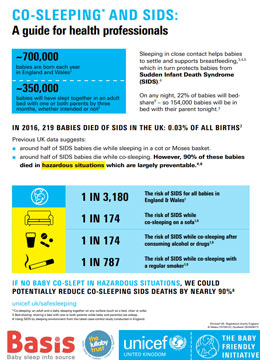Advice to avoid bed-sharing
Advice to avoid bed-sharing
Some authorities make the case that bed-sharing is a questionable (even dangerous) activity that should be abandoned by parents and discouraged by health professionals due to risks of SIDS and/or accidental deaths (e.g. Ateah & Hamelin 2008; Byard 1994; Weale 2003). The evidence for this is based upon the results of epidemiological studies that calculate the likelihood of SIDS or accidental infant deaths, based on the characteristics of babies who died compared with matched controls in large population-based studies.
Babies sleeping on their front, babies exposed to tobacco smoke, poverty, and young maternal age are all well-known factors that are associated with an increased risk of unexpected infant death (Fleming 1994). Estimates of the risk of SIDS in the context of bed-sharing are not as clear-cut, and vary widely across studies. Although McKenna (1986) hypothesised a protective effect of bed-sharing on SIDS-risk based on an evolutionary perspective, epidemiological studies have only found a protective effect for room-sharing (co-sleeping).
Assessments of the impact of bed-sharing on SIDS-risk in the UK range from no increased risk to babies of non-smoking parents (Blair et al 1999) to an odds ratio of 66.9 for infants sharing a sofa for sleep with a parent (Tappin et al 2005).
The picture is unclear because studies from different countries use different criteria to define bed-sharing (e.g. Hauck et al 2003; Carpenter et al 2004; Tappin et al 2005; McGarvey et al 2006) and have produced a confusing array of statistics that cannot easily be compared (see Côté 2006; Horsley et al 2007). The Chicago Infant Mortality Study (Hauck et al 2003), for instance, included parents and other carers in the same bed-sharing category, while the ECAS (European Concerted Action on SIDS) study (Carpenter et al 2004) defined bed-sharing as sleeping with one or both parents only. A Scottish case-control study of SIDS (Tappin et al 2005) included in the cases of ‘bed-sharing deaths’ not only those infants found dead in an adult bed, but also infants who died in a cot but who had been in their parents bed previously the same night, while numerous studies including a recent meta-analysis included sofa-sharing deaths in the bed-sharing definition. (Vennemann et al 2012).
In 2014, and again in 2021, The National Institute for Health & Care Excellence in the UK systematically reviewed the international literature for studies examining co-sleeping and SIDS. They concluded that while there was an association found between cosleeping and SIDS (particularly when parents smoke), there was insufficient evidence to say that cosleeping causes SIDS. They therefore recommended that parents be given tailored information relevant to their particular circumstances so they could make their own informed choice on bed-sharing / co-sleeping. The risks associated with sofas, drugs & alcohol, smoking, and premature babies were all emphasised. The UNICEF UK Baby Friendly statement on the NICE 2014 guidance provides more information.
The varying definitions used in international studies of SIDS mean that to ascertain which elements of bed-sharing are truly risky we must dig deeply into the ways the various studies were conducted and which variables were not included. We cannot simply rely upon the authors’ (or media’s) headline conclusions. For instance, few studies have taken infant feeding type into account in calculating risks associated with bed-sharing. It is therefore impossible to determine whether breastfeeding-related sleep contact between mothers and babies constitutes a risk to babies. However, it is unlikely that any potential risk would be of great magnitude (see Leduc & Camfield 2006) given that breastfeeding is associated with a reduced SIDS risk compared to formula-feeding in several studies (e.g., Hauck et al 2003; Hoffman et al 1988, Vennemann et al 2009; Hauck et al 2011).
One study by Baddock et al. (2012) investigated the potential for bed-sharing to increase blood oxygen desaturation and carbon dioxide inspiration, as events that heighten the risk of SUDI. Accordingly, they found that mild “desaturation events”, were more common in bed-sharing infants than co-sleeping (room-sharing) infants due to rebreathing and a warmer microenvironment. This is more likely because bed-sharing infants are more likely to have their head covered and have greater layers of bedding. Whilst they support a link between bed-sharing and desaturation events, the link between desaturation events and SIDS is not well-established.
Contrasting cultures
Just as there are cultural differences in the prevalence and practicing of bed-sharing (Salm-Ward & Doering, 2014) the way SIDS reduction and safer-sleep advice is applied by different cultures and minorities varies. For example, a study by Crane and Ball (2015) in Bradford, investigating the white British-Pakistani bi-cultural contrasts in adopting SIDS-reduction advice, found that most Pakistani mothers dismissed the advice as not relevant the them and their cultural background. For greater success in SIDS reduction, advice should be tailored to be more relevant for individual families. As of 2019 infant sleep safety guidance issued in the UK by Lullaby Trust, Unicef UK, Basis and Public Health England encourages this approach to be taken (see Resources).
Equally recognising different cultural traditions, such as bed-sharing, is important. Where their baby sleeps is the choice of each family, and those that choose to bed-share should be informed about how to do it safely. In fact as the majority of families will bed-share at some point — either by choice, by accident, or because they have no alternative, it is our view that ALL families should be informed about how to bed-share safely, just in case they find themselves doing so. Salm Ward & Doering’s (2014) study found that the most significant ethnicity-related risk of SIDS is from cultural beliefs and practices relating to bedding so the importance of a clear flat surface and not allowing the baby to overheat in the parents’ bed should be made emphasised.
See the UNICEF / Lullaby Trust / Basis infographic on ‘Co-sleeping and SIDS: a guide for health professionals‘ and the Lullaby Trust / Unicef UK / Basis / Public Health England Safer Sleep for Babies materials for more information.

